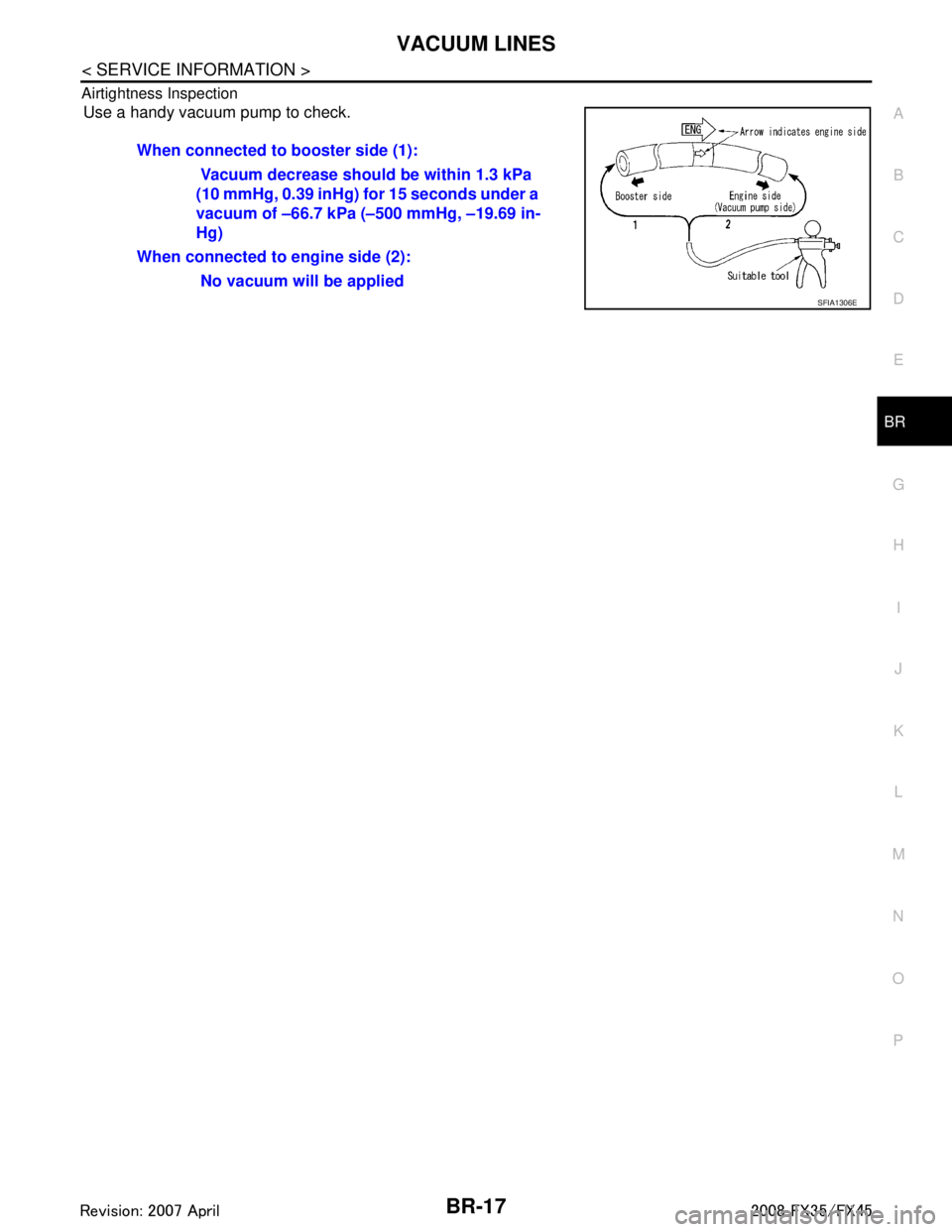2008 INFINITI FX35 engine
[x] Cancel search: enginePage 999 of 3924

BRAKE BOOSTERBR-15
< SERVICE INFORMATION >
C
DE
G H
I
J
K L
M A
B
BR
N
O P
CAUTION:
Be careful not to splash brake fluid on painted areas; it may cause paint damage. If brake fluid is
splashed on painted surfaces of body, immediately wipe it off and them wash it away with water
immediately.
Be careful not to deform or bend brake tube while removing and installing brake booster.
Replace clevis pin if it is damaged.
Be careful not to damage brake booster stud bolt thr eads. If brake booster is tilted or inclined during
installation, dash panel may damage the threads.
Install the check valve in the correct direction.
1. Remove vacuum hose from brake booster. Refer to BR-16
.
2. Remove brake master cylinder. Refer to BR-12, "
Removal and Installation".
3. Disconnect harness connector from brake booster assembly. (ICC model)
4. Remove snap pin and clevis pin from inside the vehicle. Refer to BR-6, "
Component".
5. Remove nuts from brake booster and brake pedal bracket.
6. Remove brake booster assembly from engine room.
INSPECTION AFTER REMOVAL
Output Rod Length Inspection
1. Using a handy vacuum pump, apply a vacuum of –66.7 kPa (– 500 mmHg, –19.69 inHg) to brake booster.
2. Check output rod length.
INSTALLATION
1. Loosen lock nut to adjust input r od length so that the length “B”
(shown in the figure) satisfies the specified value.
2. After adjusting “B”, temporarily tighten lock nut to install brake booster assembly to the vehicle. At this time, make sure to
install a gasket between brake booster assembly and the engine
room.
3. Connect brake pedal with clevis of input rod.
4. Install brake pedal bracket mounting nuts and bolt and tighten them to the specified torque. BR-6, "
Component".
5. Install brake tube from brake master cylinder to ABS actuator. Refer to BR-10, "
Hydraulic Circuit".
6. Install master cylinder to booster assembly. Refer to BR-12, "
Removal and Installation".
7. Adjust the height and play of brake pedal. BR-5, "
Inspection and Adjustment".
8. Tighten lock nut of input rod to the specified torque. Refer to BR-14, "
Component".
9. Bleed air. Refer to BR-8, "
Bleeding Brake System".
Standard dimension when
applying a vacuum of
− 66.7 kPa ( −500 mmHg, −19.69 inHg):
15.6 − 15.9 mm (0.614 − 0.626 in)
SFIA2146E
Length “B” : 126.5 mm (4.98 in)
SGIA0060E
3AA93ABC3ACD3AC03ACA3AC03AC63AC53A913A773A893A873A873A8E3A773A983AC73AC93AC03AC3
3A893A873A873A8F3A773A9D3AAF3A8A3A8C3A863A9D3AAF3A8B3A8C
Page 1000 of 3924

BR-16
< SERVICE INFORMATION >
VACUUM LINES
VACUUM LINES
ComponentINFOID:0000000001327624
Removal and InstallationINFOID:0000000001327625
CAUTION:
Because vacuum hose contains a check valve, it must be installed in the correct direction. Refer to
the stamp or label to confirm co rrect installation. The brake booster will not ope rate normally if hose
is installed in the wrong direction.
Insert vacuum hose for at least 24 mm (0.94 in).
Do not use lubricating oil during assembly.
InspectionINFOID:0000000001327626
VISUAL INSPECTION
Check for improper assembly, damage and deterioration.
CHECK VALVE INSPECTION
1. Clamp 2. Vacuum hose 3. Clamp
4. Vacuum piping 5. Clamp 6. Engine direction indicator
7. Vacuum hose (Build in check valve) 8. Clamp 9. Brake booster
SFIA1134E
SBR225B
3AA93ABC3ACD3AC03ACA3AC03AC63AC53A913A773A893A873A873A8E3A773A983AC73AC93AC03AC3
3A893A873A873A8F3A773A9D3AAF3A8A3A8C3A863A9D3AAF3A8B3A8C
Page 1001 of 3924

VACUUM LINESBR-17
< SERVICE INFORMATION >
C
DE
G H
I
J
K L
M A
B
BR
N
O P
Airtightness Inspection
Use a handy vacuum pump to check.
When connected to booster side (1): Vacuum decrease should be within 1.3 kPa
(10 mmHg, 0.39 inHg) for 15 seconds under a
vacuum of –66.7 kPa (–500 mmHg, –19.69 in-
Hg)
When connected to engine side (2): No vacuum will be applied
SFIA1306E
3AA93ABC3ACD3AC03ACA3AC03AC63AC53A913A773A893A873A873A8E3A773A983AC73AC93AC03AC3
3A893A873A873A8F3A773A9D3AAF3A8A3A8C3A863A9D3AAF3A8B3A8C
Page 1014 of 3924

BR-30
< SERVICE INFORMATION >
SERVICE DATA AND SPECIFICATIONS (SDS)
SERVICE DATA AND SPECIFICATIONS (SDS)
General SpecificationINFOID:0000000001327639
Unit: mm (in)
Brake PedalINFOID:0000000001327640
Brake BoosterINFOID:0000000001327641
Vacuum type
Check ValveINFOID:0000000001327642
Front Disc BrakeINFOID:0000000001327643
Rear Disc BrakeINFOID:0000000001327644
Front brakeRotor outer diameter
× thickness 320 × 34 (12.598 × 1.339)
Pad length × width × thickness 130.0 × 50.0 × 11.0 (5.118 × 1.969 × 0.433)
Cylinder bore diameter 45.0 (1.772) × 2
Rear brake Rotor outer diameter
× thickness 308 × 16 (12.13 × 0.63)
Pad length × width × thickness 83.0 × 33.0 × 8.5 (3.268 × 1.299 × 0.335)
Cylinder bore diameter 42.86 (1.6874)
Master cylinder Cylinder bore diameter 25.4 (1.00)
Control valve Valve model Electric brake force distribution
Brake booster Diaphragm diameter Primary 228.5 (9.0)
Secondary 203.0 (8.0)
Recommended brake fluid DOT 3
Brake pedal height (from dash lower panel top surface) 161.5 − 171.5 mm (6.358 − 6.752 in)
Depressed pedal height
[under a force of 490 N (50 kg, 110 lb) with engine running] More than 95 mm (3.74 in)
Clearance between stopper rubber and the threaded end of stop lamp
switch and ASCD cancel switch (or brake switch) 0.74
− 1.96 mm (0.0291 − 0.0772 in)
Pedal play 3 − 11 mm (0.12 − 0.43 in)
Output rod length 15.6 − 15.9 mm (0.614 − 0.626 in)
Input rod length 126.5 mm (4.98 in)
Vacuum leakage
[at a vacuum of –66.7 kPa (–500 mmHg, –19.69 inHg)]Within vacuum of 1.3 kPa (10 mmHg, 0.39 inHg) for 15
seconds
Brake padStandard thickness 11.0 mm (0.433 in)
Repair limit thickness 2.0 mm (0.079 in)
Disc rotor Standard thickness 34.0 mm (1.339 in)
Wear limit 32.0 mm (1.260 in)
Maximum uneven wear (measured at 8 positions) 0.015mm (0.0006 in) or less
Runout limit (with the disc rotor attached to the vehicle) 0.04 mm (0.0016 in) or less
Brake pad
Standard thickness 8.5 mm (0.335 in)
Repair limit thickness 2.0 mm (0.079 in)
3AA93ABC3ACD3AC03ACA3AC03AC63AC53A913A773A893A873A873A8E3A773A983AC73AC93AC03AC3
3A893A873A873A8F3A773A9D3AAF3A8A3A8C3A863A9D3AAF3A8B3A8C
Page 1016 of 3924

BRC-1
BRAKES
C
DE
G H
I
J
K L
M
SECTION BRC
A
B
BRC
N
O P
CONTENTS
BRAKE CONTROL SYSTEM
VDC/TCS/ABS
SERVICE INFORMATION .. ..........................
3
DTC INDEX ..................................................... .....3
C1101-C1116 ...................................................... ......3
C1120-C1136 ............................................................3
C1140-C1170 ............................................................3
U1000 ........................................................................4
PRECAUTIONS ...................................................5
Precaution for Supplemental Restraint System
(SRS) "AIR BAG" and "SEAT BELT PRE-TEN-
SIONER" ............................................................. ......
5
Precaution for Brake System ....................................5
Precaution for Brake Control .....................................5
PREPARATION ...................................................7
Special Service Tool ........................................... ......7
Commercial Service Tool ..........................................7
ON-VEHICLE SERVICE ......................................8
Adjustment of Steering Angle Sensor Neutral Po-
sition .................................................................... ......
8
Calibration of Decel G Sensor (AWD Models) ..........8
SYSTEM DESCRIPTION ................................ ....10
Schematic ........................................................... ....10
Functions .................................................................10
Fail-Safe Function ...................................................11
Hydraulic Circuit Diagram .......................................12
CAN Communication ...............................................12
TROUBLE DIAGNOSIS .....................................13
Fail-Safe Function ............................................... ....13
How to Proceed with Diagnosis ..............................13
Component Part Location .......................................16
Schematic ...............................................................17
Wiring Diagram - VDC - ..........................................18
Control Unit Input/Output Signal Standard ..............23
CONSULT-III Functions (ABS) ................................26
Self-Diagnosis ..................................................... ....26
Data Monitor ........................................................ ....28
Active Test ...............................................................30
For Fast and Accurate Diagnosis ............................31
Basic Inspection ......................................................32
TROUBLE DIAGNOSIS FOR SYSTEM ............34
DTC C1101 RR RH SENSOR-1 ..............................34
DTC C1102 RR LH SENSOR-1 ..............................35
DTC C1103 FR RH SENSOR-1 ..............................35
DTC C1104 FR LH SENSOR-1 ...............................35
DTC C1105 RR RH SENSOR-2 ..............................36
DTC C1106 RR LH SENSOR-2 ..............................36
DTC C1107 FR RH SENSOR-2 ..............................36
DTC C1108 FR LH SENSOR-2 ...............................36
DTC C1109 BATTERY VOLTAGE [ABNORMAL] ....36
DTC C1110 CONTROLLER FAILURE ....................37
DTC C1111 PUMP MOTOR ....................................37
DTC C1113 G-SENSOR .........................................38
DTC C1115 ABS SENSOR [ABNORMAL SIG-
NAL] .........................................................................
39
DTC C1116 STOP LAMP SW .................................39
DTC C1120 FR LH IN ABS SOL .............................40
DTC C1121 FR LH OUT ABS SOL .........................41
DTC C1122 FR RH IN ABS SOL ......................... ....41
DTC C1123 FR RH OUT ABS SOL .........................42
DTC C1124 RR LH IN ABS SOL .............................42
DTC C1125 RR LH OUT ABS SOL ..................... ....42
DTC C1126 RR RH IN ABS SOL ............................42
DTC C1127 RR RH OUT ABS SOL ........................42
DTC C1130 ENGINE SIGNAL 1 .......................... ....42
DTC C1131 ENGINE SIGNAL 2 ..............................42
DTC C1132 ENGINE SIGNAL 3 ..............................42
DTC C1133 ENGINE SIGNAL 4 ..............................42
DTC C1136 ENGINE SIGNAL 6 ..............................42
DTC C1140 ACTUATOR RLY .................................43
DTC C1142 PRESS SEN CIRCUIT ........................43
DTC C1143 ST ANG SEN CIRCUIT ................... ....44
DTC C1144 ST ANG SEN SIGNAL .........................45
DTC C1145 YAW RATE SENSOR ..........................46
DTC C1146 SIDE G-SEN CIRCUIT ........................46
DTC C1155 BR FLUID LEVEL LOW .......................46
3AA93ABC3ACD3AC03ACA3AC03AC63AC53A913A773A893A873A873A8E3A773A983AC73AC93AC03AC3
3A893A873A873A8F3A773A9D3AAF3A8A3A8C3A863A9D3AAF3A8B3A8C
Page 1018 of 3924
![INFINITI FX35 2008 Service Manual
DTC INDEXBRC-3
< SERVICE INFORMATION > [VDC/TCS/ABS]
C
D
E
G H
I
J
K L
M A
B
BRC
N
O P
SERVICE INFORMATION
DTC INDEX
C1101-C1116INFOID:0000000001559825
C1120-C1136INFOID:0000000001559826
C1140-C1170I INFINITI FX35 2008 Service Manual
DTC INDEXBRC-3
< SERVICE INFORMATION > [VDC/TCS/ABS]
C
D
E
G H
I
J
K L
M A
B
BRC
N
O P
SERVICE INFORMATION
DTC INDEX
C1101-C1116INFOID:0000000001559825
C1120-C1136INFOID:0000000001559826
C1140-C1170I](/manual-img/42/57017/w960_57017-1017.png)
DTC INDEXBRC-3
< SERVICE INFORMATION > [VDC/TCS/ABS]
C
D
E
G H
I
J
K L
M A
B
BRC
N
O P
SERVICE INFORMATION
DTC INDEX
C1101-C1116INFOID:0000000001559825
C1120-C1136INFOID:0000000001559826
C1140-C1170INFOID:0000000001559827
DTC Items (CONSULT sc reen items) Reference
C1101 RR RH SENSOR-1 BRC-34, "
DTC C1101 RR RH SENSOR-1"
C1102 RR LH SENSOR-1 BRC-35, "DTC C1102 RR LH SENSOR-1"
C1103 FR RH SENSOR-1BRC-35, "DTC C1103 FR RH SENSOR-1"
C1104 FR LH SENSOR-1 BRC-35, "DTC C1104 FR LH SENSOR-1"
C1105 RR RH SENSOR-2BRC-36, "DTC C1105 RR RH SENSOR-2"
C1106 RR LH SENSOR-2 BRC-36, "DTC C1106 RR LH SENSOR-2"
C1107 FR RH SENSOR-2BRC-36, "DTC C1107 FR RH SENSOR-2"
C1108 FR LH SENSOR-2 BRC-36, "DTC C1108 FR LH SENSOR-2"
C1109 BATTERY VOLTAGE [ABNORMAL]BRC-36, "DTC C1109 BATTERY VOLTAGE [ABNORMAL]"
C1110 CONTROLLER FAILURE BRC-37, "DTC C1110 CONTROLLER FAILURE"
C 1111 P U M P M O T O R BRC-37, "D T C C 1111 P U M P M O T O R"
C1113 G-SENSOR BRC-38, "DTC C1113 G-SENSOR"
C1115 ABS SENSOR [ABNORMAL SIGNAL]BRC-39, "DTC C1115 ABS SENSOR [ABNORMAL SIGNAL]"
C1116 STOP LAMP SW BRC-39, "DTC C1116 STOP LAMP SW"
DTC Items (CONSULT screen items) Reference
C1120 FR LH IN ABS SOL BRC-40, "
DTC C1120 FR LH IN ABS SOL"
C1121 FR LH OUT ABS SOLBRC-41, "DTC C1121 FR LH OUT ABS SOL"
C1122 FR RH IN ABS SOL BRC-41, "DTC C1122 FR RH IN ABS SOL"
C1123 FR RH OUT ABS SOLBRC-42, "DTC C1123 FR RH OUT ABS SOL"
C1124 RR LH IN ABS SOL BRC-42, "DTC C1124 RR LH IN ABS SOL"
C1125 RR LH OUT ABS SOLBRC-42, "DTC C1125 RR LH OUT ABS SOL"
C1126 RR RH IN ABS SOL BRC-42, "DTC C1126 RR RH IN ABS SOL"
C1127 RR RH OUT ABS SOLBRC-42, "DTC C1127 RR RH OUT ABS SOL"
C1130 ENGINE SIGNAL 1 BRC-42, "DTC C1130 ENGINE SIGNAL 1"
C1131 ENGINE SIGNAL 2BRC-42, "DTC C1131 ENGINE SIGNAL 2"
C1132 ENGINE SIGNAL 3BRC-42, "DTC C1132 ENGINE SIGNAL 3"
C1133 ENGINE SIGNAL 4BRC-42, "DTC C1133 ENGINE SIGNAL 4"
C1136 ENGINE SIGNAL 6BRC-42, "DTC C1136 ENGINE SIGNAL 6"
DTC Items (CONSULT screen items) Reference
C1140 ACTUATOR RLY BRC-43, "
DTC C1140 ACTUATOR RLY"
C1142 PRESS SEN CIRCUITBRC-43, "DTC C1142 PRESS SEN CIRCUIT"
C1143 ST ANG SEN CIRCUITBRC-44, "DTC C1143 ST ANG SEN CIRCUIT"
C1144 ST ANG SEN SIGNAL BRC-45, "DTC C1144 ST ANG SEN SIGNAL"
3AA93ABC3ACD3AC03ACA3AC03AC63AC53A913A773A893A873A873A8E3A773A983AC73AC93AC03AC3
3A893A873A873A8F3A773A9D3AAF3A8A3A8C3A863A9D3AAF3A8B3A8C
Page 1020 of 3924
![INFINITI FX35 2008 Service Manual
PRECAUTIONSBRC-5
< SERVICE INFORMATION > [VDC/TCS/ABS]
C
D
E
G H
I
J
K L
M A
B
BRC
N
O P
PRECAUTIONS
Precaution for Supplemental Restraint System (SRS) "AIR BAG" and "SEAT BELT
PRE-TENSIONER"
INFOI INFINITI FX35 2008 Service Manual
PRECAUTIONSBRC-5
< SERVICE INFORMATION > [VDC/TCS/ABS]
C
D
E
G H
I
J
K L
M A
B
BRC
N
O P
PRECAUTIONS
Precaution for Supplemental Restraint System (SRS) "AIR BAG" and "SEAT BELT
PRE-TENSIONER"
INFOI](/manual-img/42/57017/w960_57017-1019.png)
PRECAUTIONSBRC-5
< SERVICE INFORMATION > [VDC/TCS/ABS]
C
D
E
G H
I
J
K L
M A
B
BRC
N
O P
PRECAUTIONS
Precaution for Supplemental Restraint System (SRS) "AIR BAG" and "SEAT BELT
PRE-TENSIONER"
INFOID:0000000001612923
The Supplemental Restraint System such as “A IR BAG” and “SEAT BELT PRE-TENSIONER”, used along
with a front seat belt, helps to reduce the risk or severi ty of injury to the driver and front passenger for certain
types of collision. This system includes seat belt switch inputs and dual stage front air bag modules. The SRS
system uses the seat belt switches to determine the front air bag deployment, and may only deploy one front
air bag, depending on the severity of a collision and whether the front occupants are belted or unbelted.
Information necessary to service the system safely is included in the “SUPPLEMENTAL RESTRAINT SYS-
TEM” and “SEAT BELTS” of this Service Manual.
WARNING:
• To avoid rendering the SRS inoper ative, which could increase the risk of personal injury or death in
the event of a collision which would result in air bag inflation, all maintenance must be performed by
an authorized NISSAN/INFINITI dealer.
Improper maintenance, including in correct removal and installation of the SRS, can lead to personal
injury caused by unintentional act ivation of the system. For removal of Spiral Cable and Air Bag
Module, see the “SUPPLEMEN TAL RESTRAINT SYSTEM”.
Do not use electrical test equipm ent on any circuit related to the SRS unless instructed to in this
Service Manual. SRS wiring harnesses can be identi fied by yellow and/or orange harnesses or har-
ness connectors.
Precaution for Brake SystemINFOID:0000000001327654
Recommended fluid is brake fluid “DOT 3”. Refer to MA-9.
Do not reuse drained brake fluid.
Be careful not to splash brake fluid on painted areas such as body. If brake fluid is splashed, wipe it off and flush area with water immediately.
Do not use mineral oils such as gasoline or kerosene to clean. They will ruin rubber parts and cause improper operation.
Using a flare nut crowfoot and torque wrench, securely tighten brake tube flare nuts.
Brake system is an important safe ty part. If a brake fluid leak is
detected, always disassemble the affected part. If a malfunction is
detected, replace part with a new one.
Before working, turn ignition switch OFF and disconnect electrical
connectors of ABS actuator and elec tric unit (control unit) or bat-
tery negative terminal.
When installing brake piping, be sure to check torque.
WARNING:
Clean brake pads and shoes with a waste cloth, then wipe with
a dust collector.
Precaution for Brake ControlINFOID:0000000001327655
During VDC/TCS/ABS operation, brake pedal lightly vi brates and a mechanical noise may be heard. This is
normal.
Just after starting vehicle after turning ignition switch ON, brake pedal may vibrate or motor operating noise
may be heard from engine room. This is a normal status of operation check.
Stopping distance may be longer than that of vehicles without ABS when vehicle drives on rough, gravel, or
snow-covered (fresh, deep snow) roads.
When an error is indicated by ABS or another warning lamp, collect all necessary information from customer
(what symptoms are present under what conditions) and check for simple causes before starting diagnostic
servicing. Besides electrical system inspection, c heck booster operation, brake fluid level, and fluid leaks.
If tire size and type are used in an improper combinat ion, or brake pads are not Genuine NISSAN parts,
stopping distance or steering stability may deteriorate.
If there is a radio, antenna, or antenna lead-in wire (including wiring) near control module, VDC/TCS/ABS
function may have a malfunction or error.
If aftermarket parts (car stereo, CD player, etc.) have been installed, check for incidents such as harness
pinches, open circuits, and improper wiring.
SBR686C
3AA93ABC3ACD3AC03ACA3AC03AC63AC53A913A773A893A873A873A8E3A773A983AC73AC93AC03AC3
3A893A873A873A8F3A773A9D3AAF3A8A3A8C3A863A9D3AAF3A8B3A8C
Page 1021 of 3924
![INFINITI FX35 2008 Service Manual
BRC-6
< SERVICE INFORMATION >[VDC/TCS/ABS]
PRECAUTIONS
If the following components are replaced with non-genui
ne components or converted, VDC OFF indicator
lamp and SLIP indicator lamp may turn on INFINITI FX35 2008 Service Manual
BRC-6
< SERVICE INFORMATION >[VDC/TCS/ABS]
PRECAUTIONS
If the following components are replaced with non-genui
ne components or converted, VDC OFF indicator
lamp and SLIP indicator lamp may turn on](/manual-img/42/57017/w960_57017-1020.png)
BRC-6
< SERVICE INFORMATION >[VDC/TCS/ABS]
PRECAUTIONS
If the following components are replaced with non-genui
ne components or converted, VDC OFF indicator
lamp and SLIP indicator lamp may turn on or the VDC system may not operate properly. Components
related to suspension (shock absorber, strut, spring, bushing, etc.), Tires, wheels (exclude specified size),
components related to brake (pad, rotor, caliper, etc. ), components related to engine (muffler, ECM, etc.),
components related to body reinforcement (roll bar, tower bar, etc.).
Driving in the condition of breakage or excessive wear of suspension, tires or components related to the
brakes may cause VDC OFF indicator lamp and SLIP indicator lamp turn on, and the VDC system may not
operate properly.
When the TCS or VDC is activated by sudden accele ration or sudden turn, some noise may occur. The
noise is a result of the normal operation of the TCS and VDC.
When driving on roads which have extreme slopes (s uch as mountainous roads) or high banks (such as
sharp carves on a freeway), the VDC may not operate nor mally, or VDC OFF indicator lamp and SLIP indi-
cator lamp may turn on. However, this is not a malfunction, if normal operation can be resumed after restart-
ing engine.
Sudden turns (such as spin turns, acceleration turns) , drifting, etc. When VDC function is OFF (VDC OFF
SW ON) may cause the G sensor system indicate a malf unction. However, this is not a malfunction, if nor-
mal operation can be resumed after restarting engine.
Change 4 tires at a time. Be sure to use specified- size tires that have the same brand name and pattern.
Wheel sensor errors can be detected be self-diagnosis when tires have wide abrasion variations or the size
is different from the genuine tires.
3AA93ABC3ACD3AC03ACA3AC03AC63AC53A913A773A893A873A873A8E3A773A983AC73AC93AC03AC3
3A893A873A873A8F3A773A9D3AAF3A8A3A8C3A863A9D3AAF3A8B3A8C